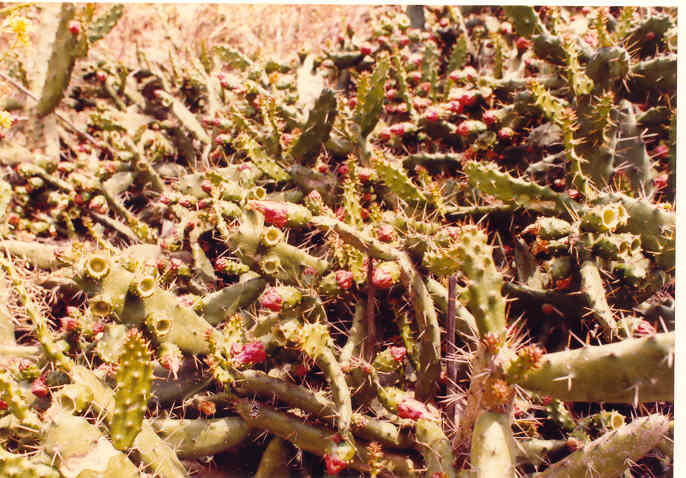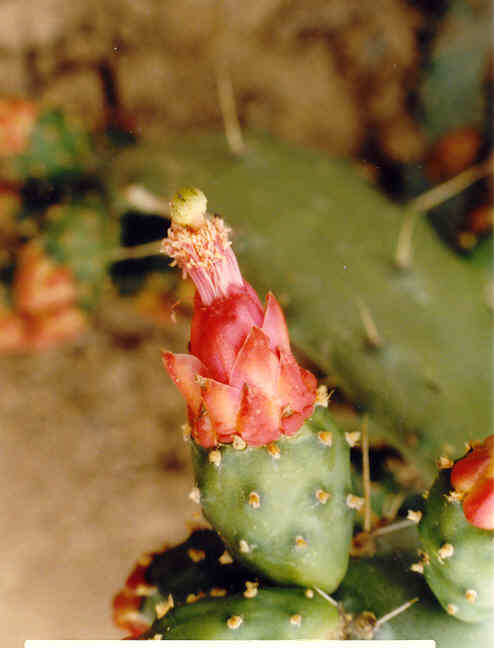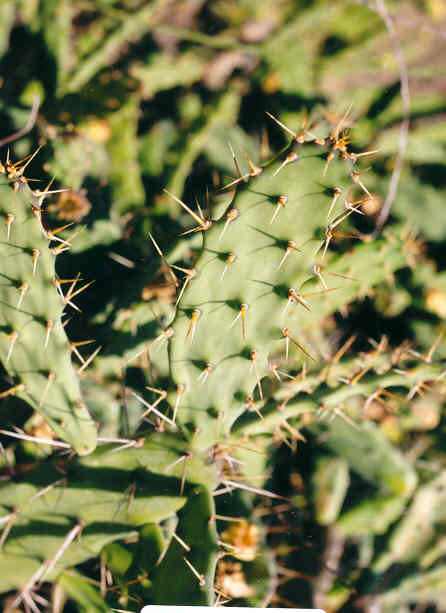
Opuntia prolifera x littoralis
Cactaceae
Native
Opuntia Hybrid
 |
Opuntia prolifera x littoralisCactaceae
Native
Opuntia Hybrid
|
May Photo
Plant Characteristics:
Sprawling, +/- 2 m. high, +/- 7 m. in diam.; older stems nearly
cylindrical, +/- 1 dm. in diam., without a trunk; joints fleshy, light green,
linear oblong, new growth 1.4-2.3 dm. long, 3.5-5 cm. wide, +/- 7 mm. thick and
sometimes upcurved about an axis perpendicular to the broad dimension, older
joints to 3.5 dm. long, these becoming oblong and later almost cylindric; spines
mostly 2 per areole, some with more, yellow; 20-25 areoles per joint; fls. +/-
2.5 cm. long, 4 cm. including exserted stamens and style; petals never fully
opening, rose to reddish-purple, inner ca. 2 cm. long; fr. subglobose ca. 2.5
cm. long, 2.5 cm. in diam., reddish to reddish purple, fleshy, spineless but
with short bristles at each areole. (my
description).
Habitat:
Not known other than both O.
prolifera and O. littoralis both occur at low elevs. along the coast from Ventura
or Santa Barbara Cos. s. to L. Calif. O.
littoralis will get inland as
far as 15-40 miles. April-June.
(Munz, Flora So. Calif.) 317,
318). John Johnson reports that O.
prolifera is or was abundant in the hills north and east of Brea, 25 miles
from the coast.
Name:
Opuntia, an old Latin name used
by Pliny, formerly belonging to some other plant.
Littoralis, of the seashore.
(Bailey 17). Prolifera,
producing offshoots. (Bailey 20).
General:
Rare in the study area with only one plant known and this on a protected
lower slope in the middle of the Santa Ana Heights area.
The area is probably the old dumpsite of an Irvine Co. farmhouse as there are
the remains of a buckboard there and Aloe humilis is found there, the
only place in upper Newport Bay where it occurs. The
opuntia plant is large and old and I presume it to have been planted near the Irvine Co.
farmhouse with cuttings thrown on the dumpsite. Fred
Roberts believes it to be a hybrid and it may have occurred on its own, however,
at this time there is no other cactus near this plant; historically things were
probably much different. One
wonders what the frequency of such a hybrid is and if other such plants are
identical or take their own shape and form?
See other Opuntias for uses. (my
comments).
Text Ref:
Munz, Flora So. Calif. 317,
318.
Photo Ref:
May 3 83 # 21,22; April 2 87 # 18A; May-June 04 #13.
Identity: by F. Roberts.
First Found: April 1983.
Computer Ref:
Plant Data 377.
No plant specimen.
Last edit 7/11/04.
 |
 |
May Photo June Photo